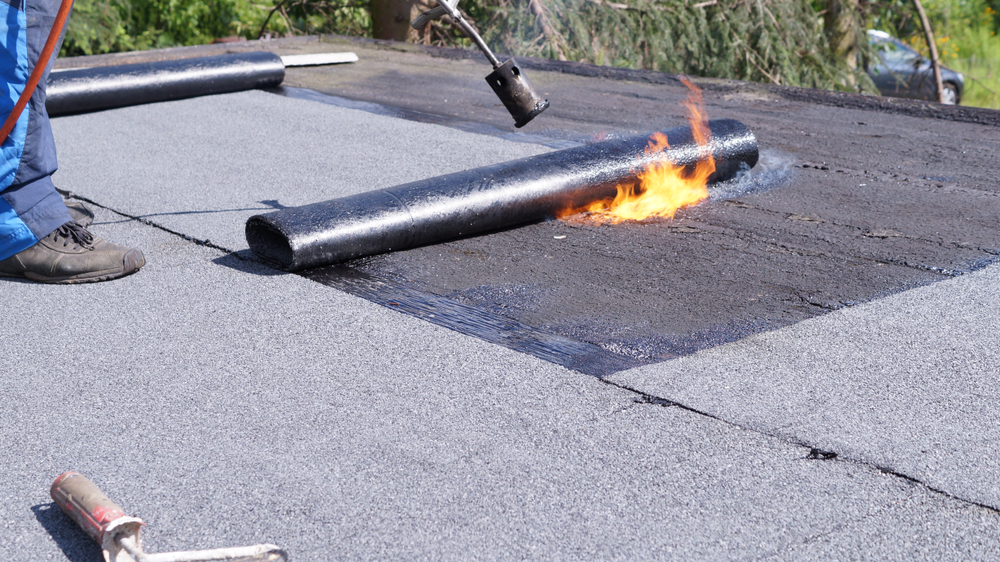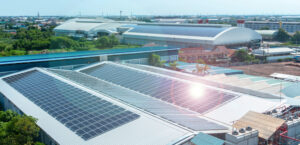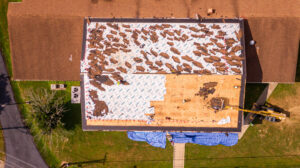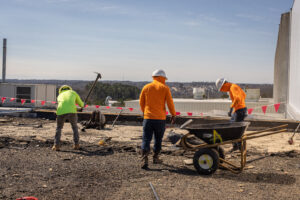Flat roofs are a common feature in commercial and industrial buildings, and the choice of roofing material can impact their durability, longevity, and energy efficiency. One popular option for flat roofs is the Built-Up Roofing (BUR) system, known for its durability and longevity. In this article, we’ll go in-depth to explain what a BUR system is, its components, the installation process, its pros and cons, and its cost.
What is a Built-up Roofing System?
Built-up Roofing System (BUR), also known as tar and gravel roofing, is a flat or low-sloping roof constructed by alternating bitumen layers (asphalt or coal tar) and reinforcing fabrics, such as fiberglass or organic felts. These layers are then reinforced and topped with a layer of gravel or a mineral cap sheet to provide protection from weathering and physical damage.
BUR systems are very effective in many different geographic areas and climates, especially in extreme temperatures and weather conditions. They are known for their durability and longevity, with some BUR systems lasting up to 30 years or more. It’s important to note that there is a difference between commercial roofers and residential roofers, so choosing the right contractor for your project is crucial.
Components of a Built-up Roof Systems
The primary components of a BUR system include:
Bitumen: A black, tar-like substance made from either asphalt or coal tar that is used to waterproof the roof.
Ply Sheets: Reinforcing layers of fabric that are used to provide structure and strength to the roof.
Insulation: A layer of material that is used to provide thermal insulation and energy efficiency to the roof.
Flashing: Strips of metal or other materials that are used to seal the edges and seams of the roof to prevent water from penetrating.
Surfacing: A layer of gravel or a mineral cap sheet that is used to protect the roof from weathering and physical damage.
Elevate BUR System Components
To elevate the performance of a BUR system, some roofing manufacturers offer premium options for certain components. For example, some offer high-performance ply sheets made from fiberglass or organic felts that have been saturated and coated with asphalt for greater strength and durability. Other manufacturers may offer reflective surfacing options that improve the energy efficiency of the roof by reflecting sunlight and reducing heat absorption.
How Does a Built-up Roofing System Work?
A BUR system works by providing a durable, waterproof layer on top of a building. The layers of the BUR system work together to create a barrier that keeps water from penetrating the building. The base layer is first applied to the roof deck, and then each subsequent layer is applied on top of it, with each layer being adhered to the previous layer with hot asphalt or another adhesive material.
The top layer of the BUR system is typically a layer of gravel or other materials that provide protection from the elements. This layer of covering also helps to reflect sunlight and prevent the roofing materials from becoming too hot, which can lead to premature aging and cracking.
Built-up Roofing Installation and Warranty

Installation of a BUR system should be performed by a professional roofing contractor experienced in installing this type of roofing system. The installation process typically involves heating and melting the ply sheet with bitumen before applying it to the layers of roofing felt. The roofing contractor may also apply a layer of gravel or other granular materials to the surface of the cap sheet to increase its durability.
Most roofing manufacturers offer warranties for BUR systems that range from 10 to 30 years. However, the lifespan of the roofing system largely depends on the quality of the installation and the level of maintenance performed.
What are the Challenges of a BUR Membrane System?
While BUR systems offer many benefits, there are some challenges that property owners should be aware of. One of the biggest challenges is their weight, as BUR systems can be much heavier than other roofing systems due to the multiple layers of bitumen and ply sheets built-up roofs have. This can sometimes require additional structural support to be added to the building.
Another challenge is their vulnerability to moisture, as BUR systems can be prone to water penetration if the flashing is not installed or maintained properly. It’s important to ensure that all seams and edges are properly sealed and that any damaged or worn areas are repaired promptly to prevent moisture from seeping in.
What are the Pros and Cons of BUR Roofs?
As with any roofing system, there are pros and cons to consider when choosing a BUR system.
Pros of BUR Systems
Durability and Longevity: BUR systems are known for their durability and longevity, with some lasting up to 40 years or more. This makes them a cost-effective choice for building owners and property managers who want a roof that will require minimal maintenance and provide long-lasting protection for their property.
Energy Efficiency: Built-up roofing systems can also help to increase energy efficiency in buildings. The multiple layers of insulation, combined with the reflective surface of the surfacing materials, can help to reduce heat transfer into and out of the building, reducing energy costs and making the building more comfortable for occupants.
Versatility: BUR systems are versatile and can be installed on a wide range of buildings, including commercial, industrial, and residential structures. They can also be used on both flat and sloped roofs, making them a popular choice for many different types of buildings.
Low Maintenance: Another advantage of BUR roof systems is that they require minimal maintenance. With proper installation and routine inspections, a BUR roof can provide many years of reliable service without the need for frequent repairs or replacement.
Drawbacks of BUR Systems:
While there are many benefits to choosing a BUR system for your building, there are also some drawbacks to consider.
Installation Complexity: BUR systems require specialized installation techniques, which can increase the cost and complexity of the installation process. Proper installation requires skilled workers who are trained in the specific installation methods and materials used in BUR systems.
Weight: Built-up roofing systems are relatively heavy, which can concern buildings with weight restrictions. Additional structural support may be required to accommodate the weight of the built-up roofing materials.
Environmental Concerns: Using hot asphalt in BUR systems can raise environmental concerns due to the emissions of toxic fumes produced during installation. Additionally, removing and disposing of a BUR roof at the end of its service life can be complicated and requires specialized handling and disposal techniques.
Built-up Roofing Cost
The cost of a BUR roofing system depends on several factors, including the size of the roof, the type of materials used, and the complexity of the installation. In general, BUR systems are more expensive than other roofing systems due to the labor-intensive installation process and the high cost of materials. However, generally, a BUR roof can range from $3 to $6 per square foot.
Common Questions People Ask About Built-up Roofing
A BUR roof is a type of built-up roofing system composed of multiple layers of roofing material. The layers are typically alternating hot asphalt and ply sheets, with a top layer of gravel or small stones. BUR systems are also known as “built-up roofs” or “tar and gravel roofs.”
BUR systems are known for their durability and longevity, with some lasting up to 30 years or more with proper maintenance. The alternating layers of the BUR system create a continuous sealed surface that provides excellent durability, resistance to foot traffic, and ultra-violet protection.
The gravel on roofs is called “ballast.”
Gravel is added to roofs for several reasons, including increasing the roof’s weight to keep it in place during high winds, protecting the roof from UV radiation and extreme temperatures, and providing a non-slip surface for maintenance workers.
A ballasted roof system is a type of roofing system that uses a layer of ballast, such as gravel or pavers, to hold down the roofing material.
A hot mopped roof is a type of built-up roofing system that involves applying layers of hot asphalt to the roof substrate, followed by layers of roofing felt or other reinforcement material.
Yes, hot mopping can be done over an existing roof if it is in good condition and does not have any moisture issues.
Common problems with built-up roofing include leaks, punctures, cracking, blistering, and deterioration of the roof surface due to UV exposure and weathering.
Built-up roofs can be a good option for flat or low-slope roofs because they provide good weather protection and can last for many years if properly maintained.
Yes, built-up roofs are commonly used for flat or low-slope roofs.
Modified bitumen is a type of roofing material that combines asphalt and rubber or plastic modifiers to create a more flexible, durable roofing membrane. Built-up roofing, on the other hand, uses multiple layers of asphalt and roofing felt to create a waterproof membrane.
3-ply built-up roofing is a type of built-up roofing system that consists of three layers of roofing felt and bitumen, topped with a layer of gravel or other ballast material.
BUR systems are a durable and long-lasting option for flat roofs in commercial and industrial buildings. The multiple layers of the BUR system provide excellent resistance to foot traffic and weather conditions, and the use of modified bitumen can enhance fire resistance and durability. When choosing a roofing system, it is important to consider factors such as location, climate, and budget to ensure that the best option is selected for the building.
Ready to take your Built-up roofing project off the ground? Reach out to Eskola today and get a free consultation and quote! Our knowledgeable commercial roofing specialists will craft the optimal solutions for your commercial building’s needs. Take advantage of this offer now, and start investing in your business’s future success with Eskola!






